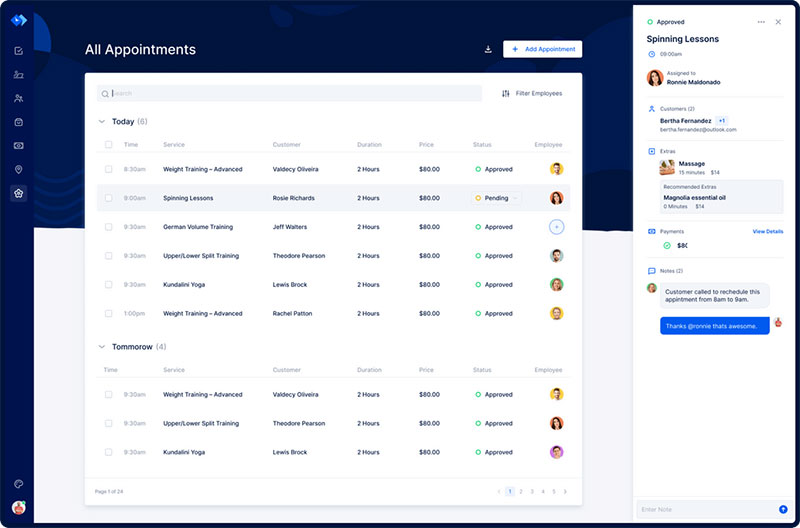When you think of a mentoring program, what comes to your mind? Perhaps you think of a traditional, one on one mentoring approach. This is a common mentoring model. However, mentoring programs can come in a variety of forms.
The mentoring models a company chooses to institute will depend on a few different factors. These include:
- How big your organization is
- How much mentoring you want to have
- Who will participate in the mentoring programs
- The results you are looking for
This article outlines 5 different kinds of mentoring models. The article will also show you how to introduce each model into the workplace and how it can help your company reach its goals.
Regardless of the model you choose, mentoring models change and grow with a company over time. If you have a model your company has been implementing for years, it may well be the case that it needs some reassessing to meet the needs of your company now.
If that is the case, don’t despair. Many of the models listed in this article are easy to integrate into the mentoring programs you already have in place.
The Difference Between Formal and Informal Mentoring
An informal mentoring relationship is constantly changing and growing, like a friendship. Actually, friends, family, and colleagues can all be informal mentors. When people are looking for advice, those are the people they first go to for help.
In informal settings, a mentoring relationship is less structured. This type of mentoring can happen over a short period of time, but longer-term informal mentoring relationships eventually adopt some kind of structure.
Here are a few examples of both:
- natural mentors: young people are exposed to people who act as mentors in their natural environment (e.g. community volunteers or even their school bus drivers);
- content mentors: young people have brief, instructional interaction with a person they trust and look up to (e.g., guest speakers);
- program mentors: young ones are introduced to mentors through a structured program (e.g., school clubs or summer camp).
On the other hand, a formal mentoring relationship is more organized. People are matched with mentors that can help them meet a specific goal or acquire specific skills. This kind of mentoring program tends to be fairer and includes more people. This is because mentoring isn’t left up to chance.
This article will focus on formal mentoring programs.
One-On-One Mentoring

This is the most traditional style of a mentoring program. One mentor, usually a senior employee, is paired with one mentee. Then a manager monitors their progress for 9 months to a year.
Each match is usually made with a lot of thought and care. The program participants are carefully selected based on specific criteria. This might include their experience level, personality, and goals. Of course, there are also other factors that come into play.
Because this is a well-known model, people feel comfortable with it. One-on-one mentoring programs allow the mentor and mentee to develop a close personal relationship. In this model, the mentee gets direct attention and support from both the mentor and the program manager.
Here are a few examples of this kind of program:
The human resources department may assign a manager to coach a new employee on the company’s procedures and policies.
A senior engineer mentors a junior engineer on the best and safest practices for their work.
This also works well if a company wants to give specialized training and attention to certain employees. They may choose to give one-on-one mentoring to employees who show leadership skills. They may also offer this kind of mentoring to workers with exceptional skills or a certain group with the goal of promoting diversity.
Group Mentoring

In this model, one mentor works with several mentees at a time. This is a great option if you want or need to carry out a large-scale mentoring program but lack mentors. A bonus effect of this kind of mentoring model is that mentees get to learn from each other as well.
Group mentoring models work best if each mentor has no more than 4-6 mentees working under their supervision at a time. The whole group meets together every 2-4 weeks to discuss their progress. This model combines the best of peer mentoring and senior mentoring. Each member of the program comes together to help each other learn.
One drawback of this style of mentoring is how hard it can be to coordinate schedules for the meetings. In addition, mentees don’t get the same level of personal attention they would in one on one mentoring. To meet this challenge, some companies assign mentors to work with a specific mentee. Then all mentees and mentors check in with a senior executive from time to time to share their experiences. This way the mentees get the benefits of both styles of mentoring.
To recap, here are the three styles of group mentoring:
- One mentor works with several mentees
- Multiple mentors and mentees work together
- Peer mentoring
Here are a few examples:
One mentor with several mentees: A senior executive mentors several employees with a lot of potential.
Multiple mentors and mentees: A group of employees at different levels of experience in the organization mentor each other.
Peer Mentoring
In this model, the mentor and the mentee are at very similar levels of experience. One example of this is known as”onboarding”. This refers to when recently hired employees mentor new employees.
In peer mentoring, each person might take turns in the roles of mentor and mentee. The end goal of this kind of mentoring model is to allow each person to learn from the other and to share experiences. Working together helps them hold each other accountable, which helps them keep growing.
This kind of mentoring model works well for a targeted program. This might include support for new parents just coming back to work, or for onboarding programs. It also gives employees a chance to develop leadership skills by practicing with their peers.
Here are some examples of how this could be applied in the workplace:
Two junior engineers mentor each other. Their shared expertise helps them discover the best practices for their work.
Two or more mid-level managers are paired up to talk about leadership and share ideas on how to help their teams to grow.
Reverse Mentoring
This is a unique kind of mentoring model. Reverse mentoring refers to when a more senior person at the company is paired with a younger employee. The goal is to share information, foster transparency, and encourage collaboration with others.
Some companies have noted tension between different generations working in the same environment. Often, this is caused by preconceived ideas and misconceptions about each generation. Reverse mentoring helps break down those barriers. As a result, employees of all age groups and experience levels work better with each other.
What would some examples of reverse mentoring look like? For example:
An employee who is comfortable using social media mentors an older team member on how to use Facebook, Twitter, and/or LinkedIn for the business.
A new college graduate mentors a senior manager on the latest mobile apps that could be useful for the company.
Flash Mentoring
As you can guess, flash mentoring is a short-term, faster style of mentoring. Its purpose is to teach a skill or key piece of information.
Flash mentoring is quicker than traditional mentoring. As a result, it allows people to learn without the commitment of a long-term mentoring program. It can also be combined with other mentoring styles. A company may decide to combine flash mentoring with group mentoring in order to share a particular skill with more employees.
It can also be used to let new mentors and mentees get their feet wet, so to speak. This kind of mentoring can be used as a trial run, or help mentors and mentees broaden their horizons before they commit to a mentorship.
For example:
A new employee goes to a senior person in the company for help with a task they aren’t familiar with.
A student meets with a professor to talk about an upcoming assignment or project.
Team Mentoring
This kind of mentoring involves multiple mentors and mentees working together. Unlike group mentoring, team mentoring usually includes several mentors working with the group at a time.
This style of mentoring is a great way to encourage inclusion and diversity. It provides a comfortable, safe environment for people with different perspectives and opinions to work together and learn from each other.
This type of mentoring also helps eliminate any possibility of favoritism. Instead, team mentoring promotes teamwork as everyone tackles challenges together.
This type of mentoring has a more flexible application than the others. In some cases, it may involve multiple mentors working with multiple mentees as a team. In other cases, it may be that one mentor is available to multiple mentees who also support each other through peer mentoring.
Your mentorship success story starts with a scheduling app to streamline your calendar
Staying organized has never been easier.
You can now manage your business and grow your brand with a single, powerful software that keeps all of your appointments in line, your clients organized and your business booming.
Trafft is perfect for business owners who need to streamline their booking experience both for their staff and their clients.
Trafft handles everything for you, even sending automated email or SMS reminders to your clients. No-shows? Not anymore!
The Trafft booking software adapts to different industries for a blissful online booking experience and employee management.
https://www.youtube.com/watch?v=aGbUg7PVtLk
Want to know more? Check out Trafft’s awesome features to see what you are missing.
FAQs about mentoring models
1. What is a mentoring model, and how does it differ from other types of mentorship programs?
An organized program called a mentoring model is created to help people advance professionally by establishing a one-on-one interaction with a more seasoned colleague.
Mentoring models, in contrast to other kinds of mentoring programs, are frequently formal and have predetermined goals, objectives, and rules.
2. What are the different types of mentoring models that organizations can implement, and what are their advantages and disadvantages?
Traditional mentoring, peer mentoring, group mentoring, and e-mentoring are just a few examples of the various mentoring styles available.
While peer mentoring entails coworkers mentoring one another, traditional mentoring entails a senior employee mentoring a junior employee. While e-mentoring makes use of technology to facilitate mentoring interactions, group mentoring entails a group of mentees working with a mentor.
3. How can a mentoring model be tailored to meet the specific needs of an organization or industry?
It is critical to evaluate the culture, goals, and objectives of the business in order to customize the mentoring model to meet the unique demands of the organization.
The program’s aims should be in line with those of the organization and should focus on developing any necessary skills or competencies.
To make sure that the program is well-received and successful, it is also crucial to take into account the needs and preferences of the mentees and mentors.
4. What are some best practices for implementing a successful mentoring model?
Organizations should set clear goals and objectives, offer mentoring training and assistance to both mentors and mentees, develop an organized mentoring process, and routinely assess the program’s efficacy if they want to successfully execute a mentoring model.
Also, it is crucial to make sure that the program supports diversity, equity, and inclusion.
5. How can organizations measure the effectiveness of their mentoring models and track progress over time?
It might be difficult to gauge the success of a mentoring approach, but some important performance indicators are mentee happiness, employee retention, and career advancement.
Also, organizations should routinely gather input from mentors and mentees and use it to enhance the program.
6. How can technology be used to enhance a mentoring model, and what tools or platforms are available?
By improving communication between mentors and mentees, granting access to resources and training materials, and expediting the mentoring process, technology can improve mentoring models. Mentoring software, online discussion boards, and video conferencing software are just a few of the platforms and tools that are accessible.
7. What are the potential challenges that organizations may face when implementing a mentoring model, and how can these be addressed?
Employee reluctance, a lack of commitment from mentors and mentees, and difficulty gauging the program’s success are all potential obstacles to implementing a mentoring approach.
In order to overcome these difficulties, businesses need to train mentors and mentees, support them, properly communicate the advantages of the program, and routinely assess how well it is working.
8. How can organizations ensure that their mentoring models promote diversity, equity, and inclusion?
Employee reluctance, a lack of commitment from mentors and mentees, and difficulty gauging the program’s success are all potential obstacles to implementing a mentoring approach.
In order to overcome these difficulties, businesses need to train mentors and mentees, support them, properly communicate the advantages of the program, and routinely assess how well it is working.
9. What are some strategies for recruiting and retaining mentors and mentees in a mentoring model?
Organizations should properly convey the program’s benefits, offer incentives for participation, and pair mentors and mentees according to their interests and aspirations in order to attract and keep mentors and mentees in a mentoring model.
In order to guarantee a great experience for mentors and mentees, it is also crucial to offer training and assistance.
10. How can organizations ensure that their mentoring models are sustainable and continue to provide value over the long term?
Organizations should routinely assess the program’s efficacy and make modifications as needed to ensure that mentoring models are sustainable and continue to offer value over the long term.
Effectively communicating the program’s advantages is also crucial, as is giving mentors and mentees regular training and assistance. Include the program in the organization’s overall talent development strategy to round it out.
Which Mentoring Models Are Best?
All kinds of mentoring are beneficial. But each one offers different benefits to an organization. Each style of mentoring serves a different purpose.
The kind of mentoring model you choose will depend on the goals, values, and culture of your organization. Decide in advance what you want to o accomplish. Think about who the program involves in your organization and what they want to gain.
It might take some time and effort to figure out which mentoring models will work best for you. You might find that there are several kinds of mentoring programs that will be a good fit for your organization.
If you enjoyed reading this article about mentoring models, you should read these as well:










